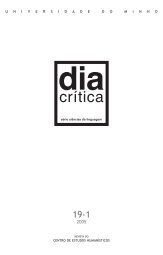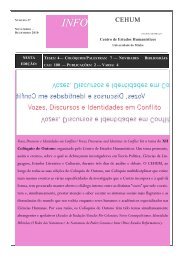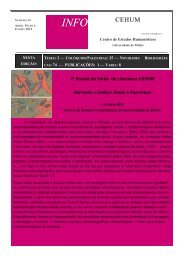Diacritica 25-2_Filosofia.indb - cehum - Universidade do Minho
Diacritica 25-2_Filosofia.indb - cehum - Universidade do Minho
Diacritica 25-2_Filosofia.indb - cehum - Universidade do Minho
You also want an ePaper? Increase the reach of your titles
YUMPU automatically turns print PDFs into web optimized ePapers that Google loves.
132<br />
5. Possible global solutions to spectrum cases<br />
OSCAR HORTA<br />
Th e way in which the problem at stake here can be approached will vary<br />
signifi cantly depending of which one of the metho<strong>do</strong>logical perspectives<br />
presented above we assume. In this section I will examine what solutions<br />
may be given to this problem according to each of these perspectives.<br />
(i) Considering Only Particular Preferences towards Outcomes. At fi rst<br />
sight, an obvious candidate to be the most preferable option is A 1 . Th e<br />
sum of the local intuitions we have when we compare consecutive pairs<br />
of alternatives in the spectrum would drive us to conclude this. However,<br />
if we reject all the constraints any principle may impose, we <strong>do</strong> not need<br />
to accept this. We no longer need to add our local intuitions. We just need<br />
to take into account the intuitions we may have towards diff erent pairs of<br />
outcomes. According to this approach, in each evaluation of a certain pair<br />
of outcomes we are not constrained by what principles may tell us about<br />
which one is preferable. Given this, we may reject A 1 if we have the intuition<br />
that another option is better than it. Th ere are several possible solutions<br />
alternative to this one that those who are just concerned with intuitions<br />
towards outcomes can assume.<br />
Suppose we have an intransitive set of intuitions regarding the betterness<br />
of diff erent outcomes: A>B>C>A. It may happen that when we look<br />
closely at the problem, we discover that the degree to which we think one<br />
alternative is better than another one may vary when we consider diff erent<br />
pairs of alternatives. So we may think A is slightly better than B and B<br />
slightly better than C, but C strongly better than A. Th is set could then be<br />
represented as follows: A> 1 B> 1 C> 10 A. In light of this, we could decide to<br />
choose C as the strongest option. And we may try to <strong>do</strong> the same in the<br />
spectrum case we are considering here. Accordingly, we might think that<br />
the strongest preference would be the one we have for A n over A 1 , and conclude,<br />
due to it, that A n is the best option.<br />
Th is solution, however, would be problematic. A n-1 seems to be better<br />
than A n , and in fact it also seems to be intuitively much better than A 1 . But<br />
then, where should we stop? A n-2 seems to be even better. In light of this<br />
problem, we may simply assume that we just need to take into account our<br />
direct intuitions regarding each of the available options over the next one in<br />
the spectrum. But this leaves us with no candidate for global betterness.<br />
Th ere is a way, however, in which we may try to look for a solution for<br />
this problem. In spectrum cases such as the ones we have seen here, A n<br />
<strong>Diacritica</strong> <strong>25</strong>-2_<strong>Filosofia</strong>.<strong>indb</strong> 132 05-01-2012 09:38:<strong>25</strong>











![Programa [pdf] - cehum - Universidade do Minho](https://img.yumpu.com/17305425/1/190x135/programa-pdf-cehum-universidade-do-minho.jpg?quality=85)




